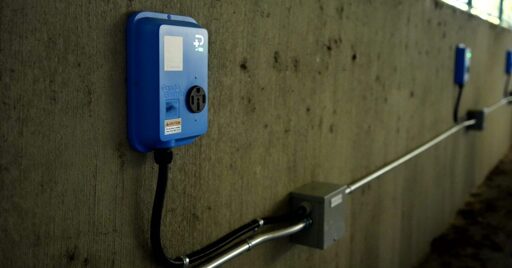Summary
Starting in 2026, California will require all new residential units with parking spaces to be EV charger-ready, significantly increasing access to electric vehicle charging.
Multi-family developments must equip at least one EV-ready spot per unit, while hotels, commercial lots, and parking renovations will also face new EV charging mandates.
Advocacy groups praise the policy, emphasizing its balanced approach to affordability and infrastructure needs.
The initiative aligns with California’s 2035 ban on new gas-powered car sales, aiming to address key barriers to EV adoption and support the state’s transition to electrification.
This is fantastic. It’s not super expensive either. Just an extra 240 volt 50 amp cable with a 14-50 outlet. If done at the build stage it’s a few hundred bucks.
It’s even cheaper than that. The minimum according to the article is 240v/20a. That smaller than a dryer outlet. You could literally use standard 12 gauge wire to it, just like you would to a dishwasher
That’s actually kind of sad. They should have mandated 50 amps
I completely agree: what’s the point of “preparing for the future” with such a big loophole, making people to have to pay all over again?
A year ago I got an EV, and went with the 50a level 2 charger, because that gives me options plus adds something to my house that people might want. I have a short commute and only go into the office a couple times a week, so technically I could use the much lower end solution, might even be able to just use a standard outlet. Technically it’s enough. But I didn’t get an EV until I knew I could make it convenient too.
I agree it should be higher, but I don’t agree that it’s useless. At my place I am using plain old level 1 charging, 120 volts 15 amps. It’s actually tolerable most of the time. I don’t always get up to 80% every night, and I do sometimes have to stop at a supercharger, but it’s usable enough for probably 90% of my charging. 240 volt 20 amp circuit call that 15 amps at the EVSE is 3.6 KW. That would be entirely usable for me.
I think they probably did it this way so it doesn’t mess with panel size and service size calculations too much. Still, I wish it was bigger.
Good point about not messing too much about service sizes, but if this is for new construction, that shouldn’t be a big deal. Actually, that’s a positive side effect for new construction: as everything is electrified, you hope your new house started with sufficient electrical service to handle it. I would be pissed off to have to update my service or panel on a new house just to support something totally expected
240V/20A will charge an EV with a 50-60kwh battery in around 12 hours. That’s a typical SUV EV battery. Unfortunately, there aren’t a lot of good options yet for EVs that aren’t SUVs, especially if you avoid Tesla. In any case, there are some options coming down the pipe, and they’ll likely have smaller batteries because they just don’t weigh that much.
That much is fine for daily use and the occasional road trip. The day after a big drive, you’ll have enough to get to work and back. The situation it might not handle is back to back long trips. Overall, not ideal, but adequate.
Also won’t handle:
- if you forget to charge, that’s it for the day
- if you have multiple cars or guests with cars
My level 2 charger will give me enough juice to run an errand in 30-60 minutes, and my typical charge is 2-3 hours. If I had a second car and only one charger, I can also get that vehicle charged in time to do something the same day
Now if only PGE would stop charging 60 cents / KwH
The cost of the outlets isn’t bad, but the whole system has to be wired and able to support those outlets all being in use. The average apartment is probably only wired for about 50-100 amps per unit, so this would mean a 50-100% increase in the capacity for the building or a load sharing system that can split the load in a way that’s compatible with everyone’s EVSE. I don’t know what that kind of system would cost. But it’s going to be more than just $200-500 per space. This is not to disparage the requirement. I think this is absolutely the right move if you are going to ban new gas cars in your state in a few years. I hope we see these kind of requirements everywhere in the next 5 years. Lack of charging prevents most non home owners from being able to consider EVs.
Nothing ever added to building code is inexpensive. It’s always many times the cost of the simplest way of doing it because it has to be done to code.
The rampant expansion of building code is a major reason for the expense of housing.
Downvote away but you know it’s true.
You know why we have 99% of the regulations we do? Because without them houses we’re catching fire and killing everyone inside, or collapsing in a stiff breeze killing everyone inside.
Generally regulations exist because uncountable numbers of people died first.
While I agree, there is a line where the addition of more safety features just adds up little by little over the years and makes houses unnaffordable.
And at some point people dying on the streets from being homeless will surpass how many lives are being saved by said safety features.
Now, if we have reached that point yet I cannot say but the line is there and it will be crossed at some point if we haven’t yet.
Sure, but then at some point it became a nightmare of expensive stupid things like running conduit for every electrical line line in a wall or ceiling (Chicago) that some bureaucrat put in to justify a pay raise. It’s raised the cost of building a house several times faster than inflation, and a major reason there’s a housing shortage.
You can’t install an electrical outlet if it’s not to code now. The “code” for electric circuits has been set for decades, and when updated, affects them all.
Requiring another circuit on a building with dozens/hundreds of circuits already doesnt add any extra burden, especially at the build stage like the commentor above said. Adding electrical when the walls are open is easy as shit.
Making up a regulation boogeyman about mundane, everyday building projects doesnt actually make them difficult, no matter how much you want to pretend they are.
Lmao. If you ever worked in construction you’d know that 1. code compliance is not that hard 2. you do not want the random contractor chucklefucks making it up on the fly without a sanity check from the inspector. Be glad your house doesn’t burn down because knob and tube isn’t code compliant.
*Also, you can absolutely build a small cheap house that is code compliant. The reason nobody does is because banks dont want to lend for it and builders want the better margins that come with a larger more upscale house.
Downvote away but you know it’s true.
You don’t know what others know. Building codes vary tremendously between regions. Imo zoning and real estate speculation are MUCH more significant drivers than the cost of design and construction. But my opinion is based on my experiences in my region.
Maybe, but I prefer my new house be suitable for modern life, and considering that from the beginning is the most cost effective way to do that.
You’re also missing the fact that most houses are previously owned. Sure we update building code all the time, so houses gradually get better, but the majority of pre-owned houses are not affected, remain cheaper.
For my own town, houses are extremely expensive, but I had an interesting conversation with my insurance company. They claim they can replace a completely burned down house for less than 1/3 the purchase price. The land is most of the cost of a house, and cost of building code is negligible
I think there’s some merit to both sides of this. Using codes to mandate quality construction is a good thing IMHO. Even when it increases building cost.
What I dislike is the fact that every little municipality has their own individual special snowflake set of building codes. Some use one version of the national code, others use another version of the national code, others use the national code with a whole bunch of special stuff added on, etc. Then throw in wildly different enforcement and inspections and a handful of inspectors who just want to see it done their way code be damned and it becomes a confusing morass that needlessly increases cost.
Finally, a nuanced answer to my comment. This is exactly what I’m getting at. By the time you deal with the whole scope of the project, every little thing adds to the cost way out of proportion to just doing it. I can slap a 50A plug in, the code isn’t complicated, but if you don’t want to have a go around with an inspector, you pay an electrician exorbitantly to get the final result. When you get everyone on a project involved in getting that done, it’s several times the hundred dollars of the actual materials. Even if it’s just part of an initial project scope.
You start getting region-specific bullshit like EMT conduit for powerlines in the mix, and inspectors that will contradict themselves in the same sentence, and in the end, you’re paying $400-500/sf for putting up a house when 20 years ago it was $150-200. It’s gotten crazy, and so little of it makes an appreciable safety or efficiency difference anymore. Look at arc-fault breaker code now, these aren’t preventing any significant amounts of fires, but every breaker is 10X the cost of a normal breaker. And there are only a couple circuits that don’t need them now according to code.
Yeah I’m also not a fan of the arc fault breaker thing. I get the concept, but there should be a calculation of expense caused versus safety increase.
A good example of that in another field is NHTSA is going to start requiring seat belt reminders and nag beeps for every seat in the vehicle. This will increase the cost of every single vehicle, annoy the hell out of drivers who store cargo in the backseat, and the problem it addresses? Yearly 50 deaths and a few hundred injuries caused by unbelted passengers. Most of whom will probably ignore the nag beep anyway- it’s 2024, if you don’t wear your seatbelt because you want to stay alive you’re not going to start wearing it because of a nag beep. Thus you have yet another regulation, yet another little specification box that has to be checked building a new car, and yet another bundle of sensors and wires and harnesses and programming for every single vehicle (which isn’t free, those costs will be passed on to the person who buys the car) all for a change that will probably have zero practical benefit whatsoever but will cause a ton of annoyance when drivers throw their groceries in the back seat. And it may even make the problem worse- The driver who puts groceries in the back will probably buy one of those defeat devices that’s like a seat belt buckle but with no seatbelt and you put it in the slut so the car thinks you are buckled in. And that might actually reduce the number of people who wear the seatbelt in the back.
Great to see this. In 10 years ice cars will not be sold so this needs to happen now.
Now if only we could build way more new residential units in CA.
I was going to say. I’m sure this will be great… for all 25 new homes built in CA that year!
Unfortunately every apartment I have lived in with charging adds a massive markup to the electricity coming out of the chargers. At one place we were paying $150/month for a space with an EV charger and the electricity coming from the charger was still billed at around 10x the base rate. It was far cheaper to fill our plugin hybrid with gas than to use the charger in our parking space.
I’m sure the same will apply here. It doesn’t help anyone if the complex is allowed to gouge the tenants on the electricity usage.
In theory chargers being more readily available will help with this. If they mark up the electricity 10x and all the tenants just charge at work instead, there’s a motive to make the price more competitive. In practice we might just end up with more AI price fixing and consumers with no recourse.
Ironically, the chargers at my office ALSO charge a big markup.
Competition is good, but landlords at offices and apartment buildings have a somewhat captive customer base who will often pay exorbitant prices for convenience.
Renters are not that captive of customers. Once it becomes a common amenity, renters will start considering it as part of the rent when deciding where to live. Just like they do with utilities, garbage collection, and other amenities that landlords can charge for outside of base rent.
Yeah, it’s really annoying. My ex’s association just voted against chargers. The plan was to set aside a distant parking lot and have a service come in to run them, profit off them.
The thing is these are townhouses with front service entrance, mostly with parking spots just across the sidewalk. It would be cheaper and easier to run a wire from the service entrance under the sidewalk, to a pedestal by the spot, and let it be part of their regular electric bill. This would also let you phase it in over time, rather than spend a ton of money at once
Frankly incredible that the NEC isn’t requiring this in all new editions yet. Absurdly short sighted. Like, it’s just 1 circuit to a garage if a garage is present. All the yokel states can refuse to adopt that section if they want, whatever.
Run two, for a future battery.
An ESS is a bit of a different animal though. They are generally wired directly to the meter’s output, before any circuits and may even come with their panel that would then control all the circuits in the house.
So run the wiring. It will cost nearly nothing to do that while also pre-wiring for EV charging vs doing it later for $$.
This is great. Now do battery storage.
That would be hella expensive
Not to be battery-ready. I’m not suggesting batteries get installed.
Most modular home battery banks can take EV chargers as an input. I know Ecoflow can, and I expect Anker solix can too. These circuits could charge battery banks instead, which the cars could plug into.
Sounds like they are getting battery storage ready.
It doesn’t cost much to run another conduit and breaker to support a battery that the electric company will allow you to discharge to the grid for $$.
I’d rather add the support for it.
At the scale of the electrical inputs for medium-large scale apartment buildings, the cost to be battery-ready isn’t measured in dollars but in cubic feet you’re reserving for the purpose. The breakers and line (and sometimes full transformer banks) already have to exist to distribute grid to the sometimes hundreds of units of apartment, so converting a standard demarc to one which would support a battery array wouldn’t be more than installing the shunts and electronic controls. 1 afternoon for a 2-3 man team and maybe a bucket truck if you’re feeling fancy.
The problem is that every square foot of floorspace is planned for in these complexes, and there’s a zero percent chance that any builder is going to allocate the raw square/cubic feet to grid storage without the grid operator or city paying cash for it, and maybe not even then.
Now, if you want to try to legislate that all parking must be built on top of batteries or something, that might be workable, but I would consider putting it in the buildings themselves to be untenable.
A lot of parking is in a garage. If each garage space already supports EV charging, it’s not a lot more to support a battery too. Paired with the right tech you can limit the amount of current feeding all these things.
Batteries take up about 5’x4’x8”. The biggest obstacle is routing individually metered power to garage space.
Keep in mind that natural gas piping may not be needed, freeing up a decent amount of space, cost, and complexity.
Which is exactly why we’d expect it lmao.
Carry on California and tell the MAGAts to shove it up their asses.
It’s good to know the rich people will be able to charge their expensive cars.
The goal is to start making charging ubiquitous, so it will eventually be available to everyone. Let wealthy early adopters pay to build out the infrastructure and the market, so it will be everywhere ready to use
False, The used Chevrolet Bolt, Bolt EUV and Nissan Leaf EV’s are affordable and there are plenty of them on the market with low mileage.
that’s not even mentioning the Chinease cards from manufactures like BYD (outside the US)
@MicroWave Granted, I live in New Jersey, so this doesn’t affect me. But what about for those of us who don’t drive? I, for example, am totally blind. Why should those of us without cars have to pay for renovations that we don’t need? What about people who don’t own or want these cars, and who don’t have any friends who do? It says for new residential buildings, but then, it talks about multi-family ones, so I’m assuming that existing homes would require them as well.
deleted by creator
Don’t they need to make it mandatory to increase capacity first? Most average residential streets probably dont have enough power to charge an EV on every address simultaneously.
Most average residential streets probably dont have enough power to charge an EV on every address simultaneously.
[citation needed]
I’m not saying you are wrong, but this sounds very much like a statement made definitively because it sounds like it might be true but has no particular basis in fact. I’d like to know if you have those facts.
It’s likely true, but doesn’t have to be, and the fact that this is being phased in with only new units means the power company can plan for it.
The transformers for the neighborhood can provide a certain amount of kVA at once. If all houses on a single transformer drew their max load, they would overload it. The power company plans on that not happening, because people vary their load from minute to minute. A hair dryer goes on in one building when an electric stove is turned off in another.
A few of those houses could upgrade their service. We upgraded ours from 100A to 200A when we installed solar and got EVs. However, if all our neighbors tried to do that, the power company would tell the last few on the list that they couldn’t provide capacity (possibly more than a few). This is why smart circuit breaker boxes are important. They can be programmed to turn on certain circuits for high draw items, like electric dryers or an EV charger, in a round-robin fashion so nothing is drawing too much at once. People can get one of those and keep their 100A service.
When it’s building new, though, the power company is consulted on how much power the unit needs and they plan accordingly. It’s a non-issue for this purpose.
I’ve yet to find any actual data on typical residential area line capacity - I don’t know the right questions to ask. So when you say “it’s likely true” what evidence are you basing this on? Did your power company actually tell you that they didn’t have capacity for “the last few on the list”?
Google results have gone to dogshit, but If it wasn’t true, there wouldn’t be a reason for smart circuit breaker boxes.
That is pure conjecture. And I thought the main reasons for a smart panel were things like energy monitoring, solar integration and optimizing charging of EVs.
This is completely untrue. While there might be some streets unable to do this, it is definitely not most.
A) This requires 20A charging, which is lower power draw than a normal electric dryer. Are you super concerned about houses having dryers? What about air conditioners? They pull literally 3 times the power. How can we possibly install air conditioners in every house?!?!
B) The vast majority of these will be used late at night, when most electric draw is at a minimum (like air conditioners and dryers).
Somewhat true but this won’t happen overnight and the power companies will upgrade capacity to meet the needs over time
deleted by creator











